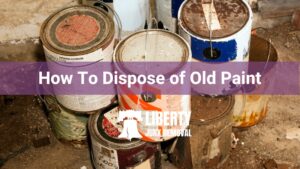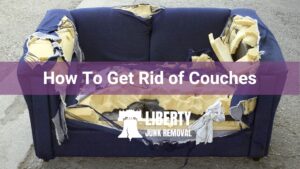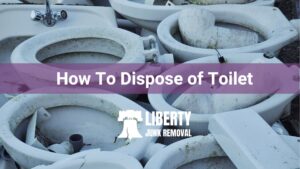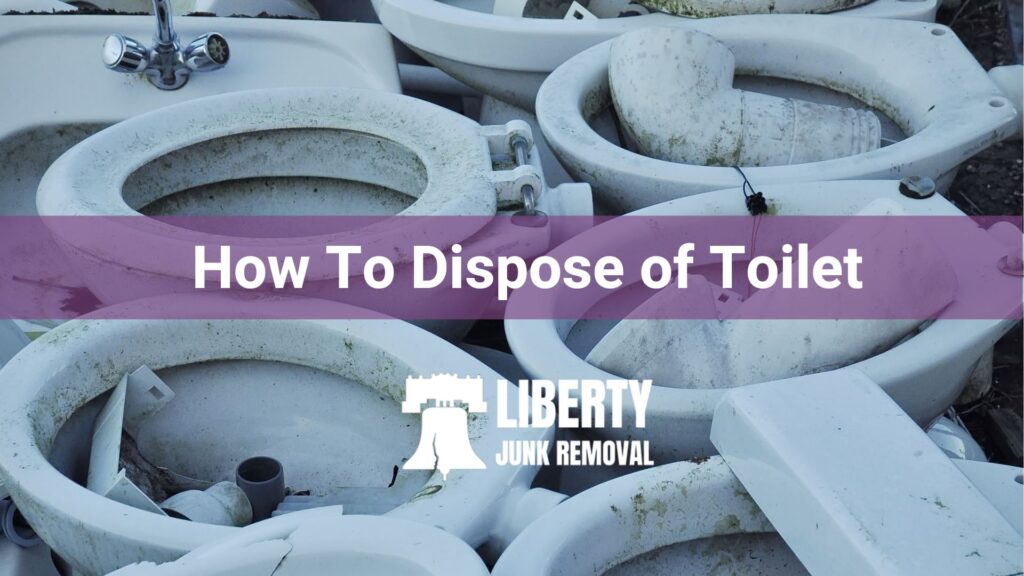Imagine the porcelain throne that once reigned in your bathroom now becoming an environmental burden. Landfills are already overflowing, and improper disposal can lead to ecological damage. Yet, the options seem limited and confusing.
Can you recycle a toilet? Is landfill disposal the only route? What about upcycling?
These questions can turn the simple act of disposal into a puzzle, which we’ll help you solve. If you want to know your best options on how to dispose of a toilet, read on.
DIY Removal and Disposal
Removing a toilet by yourself requires certain safety precautions, and you must have all the necessary tools ready before starting.
Tools and Equipment Needed for Self-Disposal
For DIY toilet removal, you will need the following set of tools:
- Adjustable wrench for loosening and tightening nuts
- Screwdriver for removing screws
- Putty knife to scrape away old caulking or wax
- Bucket to collect water
- Gloves for protection
- Hacksaw for cutting stubborn bolts (optional)
- Plunger to clear water from the bowl
- Shop vacuum for water removal
- Tarps or old towels to protect the floor
It’s also helpful to have a utility knife and a wire brush for additional tasks during the removal. Gather all these tools before starting the removal process to ensure a smooth operation.
Step-by-Step Guide to Removing and Disposing of a Toilet
This guide outlines the process of removing and disposing of a toilet, broken down into manageable steps to ensure safety and efficiency:
1. Preparation and Safety Measures
Flush the toilet to drain water from the tank and bowl. Use a sponge or a bucket to remove any remaining water. Place towels or rags around the toilet to absorb any spills.
2. Disconnecting the Water Supply Line
Ensure the water supply to the toilet is turned off. Use an adjustable wrench to disconnect the water supply line from the bottom of the toilet tank. Be prepared for a small amount of water to spill out when disconnecting the line.
3. Removing the Toilet Tank
If the toilet has a separate tank and bowl, remove the tank first. Unscrew the mounting bolts connecting the tank to the bowl using a wrench. Carefully lift the tank off the bowl and set it aside on a towel or tarp.
4. Unbolting the Toilet from the Floor
Remove any caps covering the floor bolts on each side of the toilet base. When unbolting the toilet from the floor, be cautious, as the nuts may be corroded and difficult to remove. Use a wrench to unscrew the nuts from the floor bolts. If they are corroded, apply penetrating oil or use a hacksaw to cut through them.
5. Removing the Toilet Bowl
Gently rock the toilet bowl side to side to break the seal with the floor. This may require some effort. Once the seal is broken, carefully lift the toilet bowl and move it away from the area.
6. Cleaning and Preparing the Area
Remove the old wax ring from the toilet flange on the floor and dispose of it properly. Clean the area around the flange and inspect it for any damage.
7. Disposal of the Old Toilet
Depending on local regulations, you may dispose of the toilet via curbside pickup, a recycling center, or a landfill. For recycling, separate porcelain parts from non-porcelain components as required by the facility.
Donation and Reuse Options
To donate an old toilet, Habitat for Humanity Restores are a great option. They accept new or gently used plumbing fixtures, including toilets, and the proceeds from sales help Habitat’s community work. It’s important to check with the local ReStore for specific donation criteria, as they can vary by location. Other local charities or thrift stores might also accept toilets, but it’s always best to call ahead and confirm.
Preparing a Toilet for Donation
Before donating a toilet, it should be in good working order, clean, and free of significant damage. Ensure that the toilet does not have any chips or stains in the porcelain, and remove any non-porcelain parts as they may not be accepted.
It’s also helpful to make sure all parts are intact and functional. If you’re not sure whether your toilet meets the criteria, it’s a good idea to contact the donation center in advance for guidance.
Environmental and Social Benefits of Toilet Donation
Donating a toilet instead of discarding it helps reduce landfill waste and supports recycling efforts. Additionally, your donation can support affordable housing projects and other community initiatives.
By donating, you not only contribute to environmental sustainability but also provide resources that can help others in need. ReStores, for example, use the proceeds from sold items to help families build decent and affordable places to live.
Recycling Options for Old Toilets
To recycle your old toilet, start by locating a local recycling facility that accepts porcelain toilets. You can find such facilities through a search on websites like Earth911.com, which provides extensive recycling databases.
Additionally, contacting your local waste management company or municipality can help you find recycling centers in your area. Some centers may require a pre-appointment or specific preparation of the toilet before accepting it for recycling.
The Process of Recycling Ceramic Toilets
The recycling of ceramic toilets typically involves the following steps:
- Ensure the toilet is completely drained and disconnected from the plumbing.
- Most recycling centers require you to remove non-porcelain parts, such as the tank hardware, before they can accept the toilet. These facilities may have specific guidelines for recycling, so it’s important to follow their instructions.
- After the toilet is prepared, it can be taken to the recycling facility, where it will be processed and repurposed, often into new ceramic products.
Benefits of Recycling Toilets
Recycling toilets offers several benefits:
- It helps reduce landfill waste, as toilets are made of non-biodegradable porcelain.
- This eco-friendly disposal method conserves resources and minimizes environmental impact. Some recycling programs repurpose crushed porcelain from toilets as construction materials, which contributes to sustainable building practices.
- By recycling, you’re not only disposing of your old toilet responsibly but also supporting a circular economy and environmental conservation.
Professional Junk Removal Services
When selecting a professional junk removal company for toilet disposal, there are several factors to consider to ensure that you make the best choice, depending on your requirements:
- Assess Your Needs: Understand the type and volume of items, including your old toilet, that need disposing of.
- Research Local Companies: Look for companies with positive reviews and a solid reputation in your community. Recommendations from friends or family can be particularly valuable.
- Verify Licensing and Insurance: Ensure the company is licensed and insured to protect against potential damages or accidents during the removal process.
- Evaluate Environmental Practices: It’s important to choose a company that adopts eco-friendly disposal methods. Check whether they recycle or donate items where possible.
- Obtain Transparent Pricing: Make sure you understand the pricing structure and ask about any additional fees for special handling or disposal.
- Inquire About Services and Equipment: Ensure the company has the necessary equipment and offers the specific services you need for your project.
Liberty Junk Removal is a trusted choice for junk removal services. We offer a wide range of solutions for different types of junk, including old toilets. Plus, we prioritize environmentally friendly processes and high-level customer service.
Our pricing for toilet disposal is based on the volume of junk, specifically how much space it occupies in our truck. We also provide a no-obligation quote upfront for transparency and no surprises in pricing. Visit our page for more detailed information about our price list.
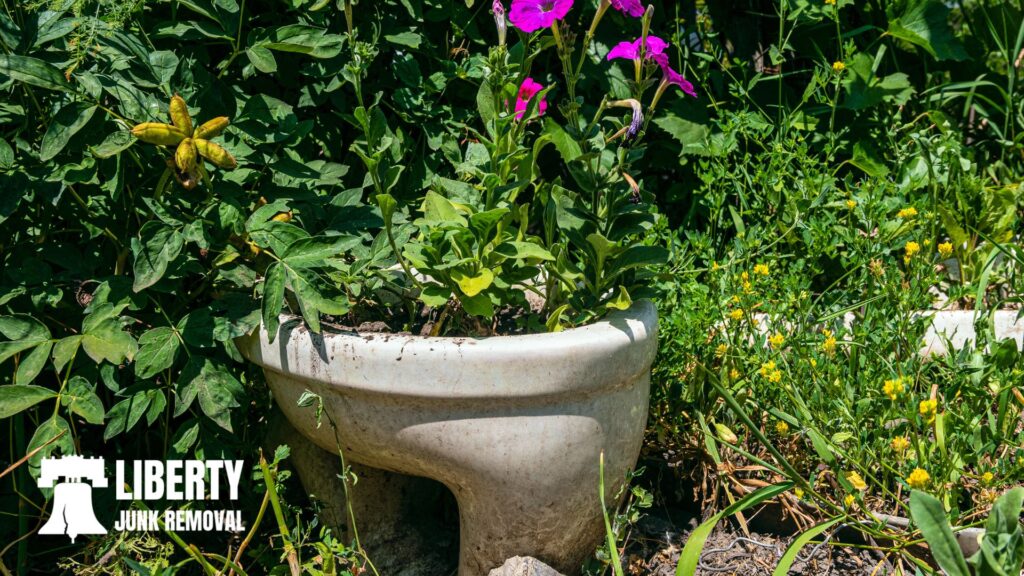
Exploring Upcycling and Creative Reuses
Upcycling old toilets provides an opportunity to creatively repurpose them into functional or decorative items. Here are some innovative ideas:
- Garden Planters: You can fill the bowl with soil and plant flowers, herbs, or small vegetables. This use is not only practical but also adds a quirky element to your garden.
- Artistic Projects: You can paint, add tiles, or use other decorative techniques to turn the toilet into an artwork. This can include using the toilet lid or seat as a blank canvas for painting or as a frame for photos and other decorative items.
- Alternative Furniture: An old toilet can be converted into a chair. Clean it thoroughly, secure the lid to the seat, and paint it to match your decor. Adding wheels can make it a unique and mobile piece of furniture.
- Pet Bowls or Fish Tanks: The toilet bowl can be sanitized and used as a water bowl for pets. Alternatively, the tank can be repurposed as a fish tank, though this requires some plumbing knowledge.
- Yard Decorations: Use the toilet as a decorative element in your yard. Fill it with potting soil and use it as a planter for flowers.
- Garden Chair: Paint the toilets in various colors and use them as garden seats. Add waterproof cushions for comfort.
- Architectural Salvage: Vintage toilets can be donated to architectural salvage firms for preservation or to be featured in exhibitions.
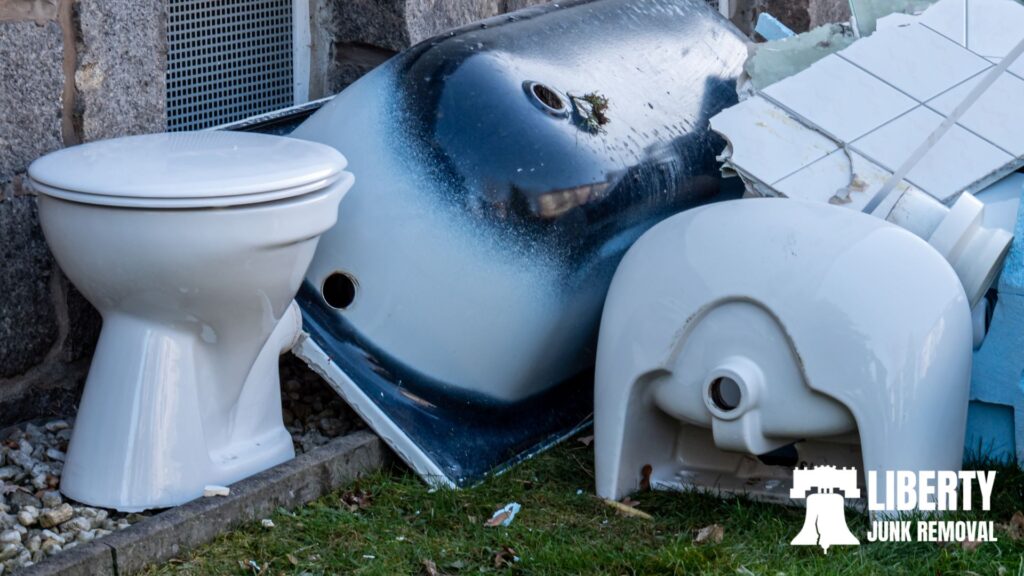
How To Dispose of Toilet: Alternative Methods
If upcycling or recycling is not your thing, you can look at other options to dispose of your toilet, such as:
Community Programs for Bulky Waste
Various cities and communities have programs specifically designed to manage bulky waste, which includes items like old toilets. For instance, the City of San Antonio provides brush and bulky item collection services, including community cleanup events to help dispose of bulky items in neighborhoods. These events often include partnerships with waste management companies and focus on both recycling and reuse to reduce landfill waste.
In Portland, the Bureau of Planning and Sustainability is developing new opportunities for the collection of large household items that are hard to dispose of through regular garbage and recycling services. These include community-led waste collection events with support in the form of guidance, event plans, and funding through Metro’s Regional Refresh Fund.
Innovative Disposal Technologies for Toilets
Addressing the disposal of bulky waste like toilets involves not only community programs but also innovative technologies and solutions. One approach is the use of special collection vehicles with hydraulic lift systems for safe and efficient handling of heavy items.
Public education on the reuse and recycling of bulky items is also vital. In some places, there are swap events where residents can exchange usable bulky items.
Additionally, legislative policies such as Extended Producer Responsibility (EPR) laws are being considered. These laws shift the responsibility for disposal from municipalities to product manufacturers. For example, Connecticut’s EPR law for mattresses has been effective in facilitating proper disposal and recycling. Such models could potentially be adapted for other bulky items, like toilets.
These programs and technologies not only help in managing bulky waste like old toilets but also contribute to environmental sustainability and community welfare. It’s important to check with local waste management authorities or municipal websites for specific programs and guidelines in your area.
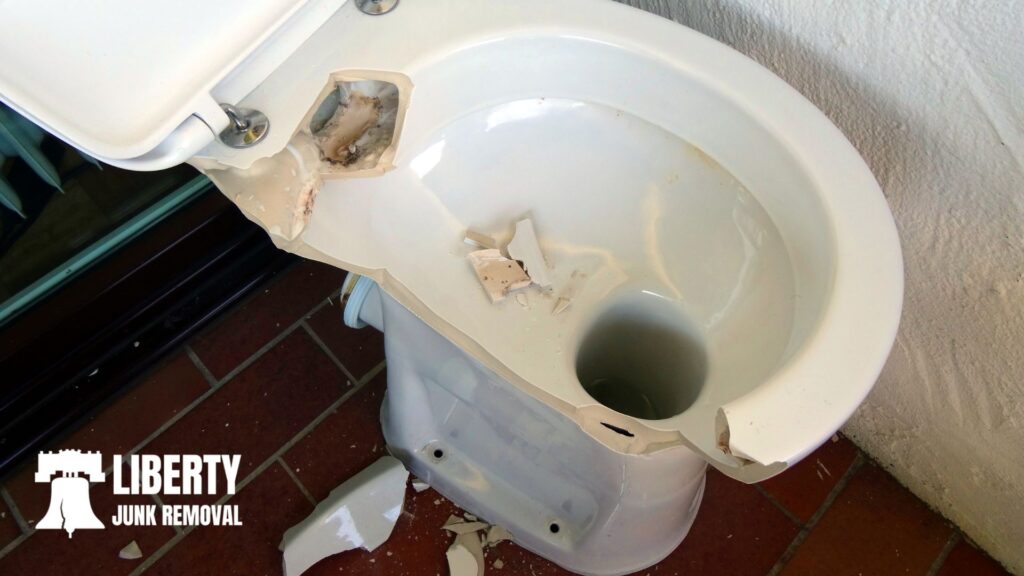
When Landfill Disposal is the Only Option
Landfill disposal of a toilet should be considered a last resort, typically when other options like recycling or donation are not feasible. It is important to check with local waste management facilities or environmental services to confirm that they accept toilets. Some landfills have specific guidelines or restrictions for accepting toilets, and in some cases, there might be a fee involved for disposal.
Preparing a Toilet for Landfill Disposal
Before disposing of a toilet at a landfill, ensure it is prepared properly. Disconnect the toilet from the plumbing and flooring, and remove any non-porcelain parts, as these may need to be disposed of separately. If storing the toilet temporarily before disposal, seal it in a plastic bag or wrap it in a tarp to avoid contamination.
Understanding the Long-term Impact of Landfilling Toilets
Disposing of toilets in landfills has long-term environmental impacts. Toilets, especially those made of porcelain, do not decompose and can take up significant space in landfills. This contributes to landfill overuse and can potentially lead to environmental hazards.
Additionally, the production and transportation of new toilets to replace those discarded ones consume resources and energy, further impacting the environment. It is always advisable to consider more sustainable options, such as recycling or donation, to minimize environmental impact.
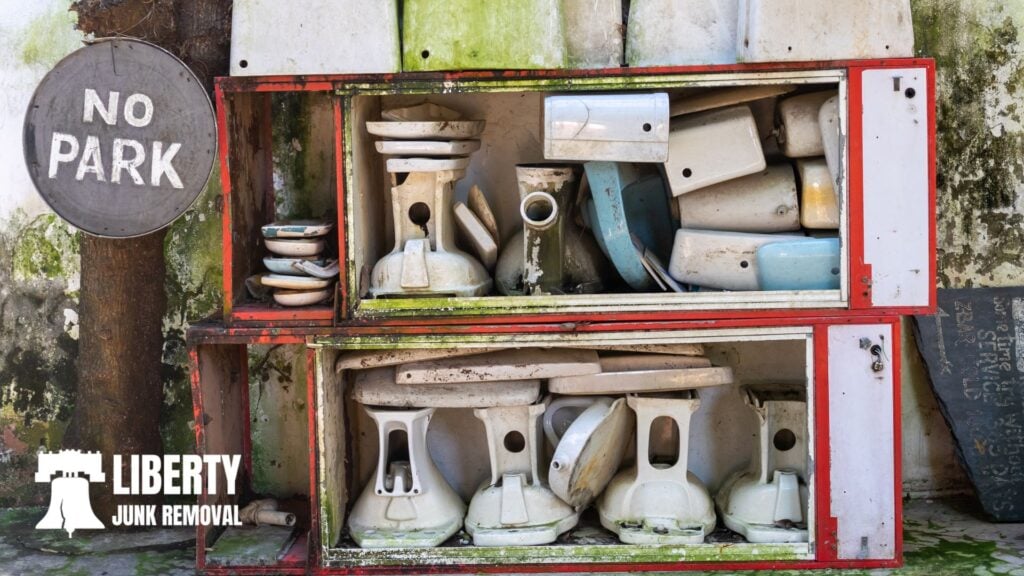
Dispose of Your Old Toilet Responsibly
Old toilets, particularly those made of porcelain, don’t decompose and can occupy significant space in landfills. Innovative disposal methods, like recycling and upcycling, not only minimize landfill waste but also conserve resources. Repurposing old toilets for creative uses or donating them adds value, extends their life cycle, and helps reduce the environmental footprint.
If you’re facing challenges in disposing of an old toilet, remember that eco-friendly disposal is not just a personal responsibility but a community effort. At Liberty Junk Removal, we understand the importance of responsible disposal. We are committed to handling your old toilets with the utmost care, ensuring they are disposed of in the most environmentally friendly way.
Reach out to us for responsible disposal solutions that align with your eco-friendly goals.


